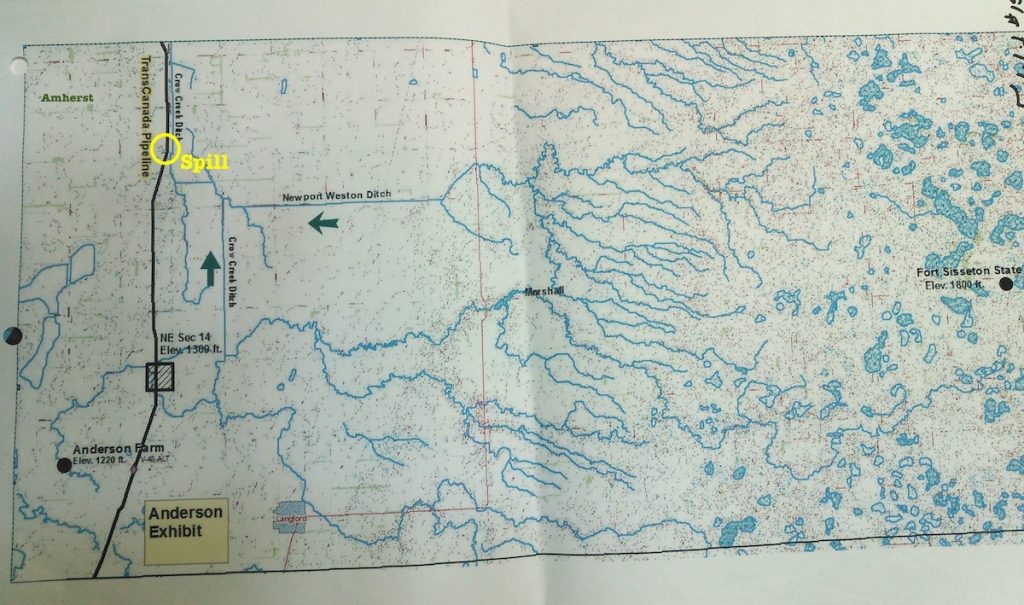Amherst-area retired farmer Don Tisher shrugs at the Keystone pipeline oil spill (“Accidents happen”) and tells KSFY, ““It’s nothing that won’t be taken care of efficiently and good…. I’m not going to live long enough to not need gas and oil and fuel and this is the safest, the most economical way of transporting it.”
Don Tisher was apparently not as nonchalant about the Canadian tar sands oil pipeline back in 2007. Don and Gene Tisher were among dozens of of South Dakotans against whom TransCanada initiated eminent domain proceedings to seize land for the Keystone pipeline.
The plat map I got from Kent Moeckly and Lillian Anderson yesterday shows that Don Tisher and his relatives own several quarters of land around Amherst, including four quarters in Weston Township through which TransCanada ran its leaky pipeline.

The plat map indicates that the quarter where the spill took place is owned by Bill Tisher, who in 2007 firmly opposed having the pipeline run through his land:
Landowner Bill Tisher says, “Well I was born in 1927 and I think my dad bought it around that time, and we’ve finally got it paid for..which was hard times.”
Every time TransCanada has asked Bill Tisher and his wife Phyllis for permission to build a pipeline through part of it, they’ve always given one answer.
Phyllis Tisher says, “No we are not interested. We do not want in anywhere near us.”
But according to a letter they got in the mail, the pipeline would run through this field. There would only be a row of trees separating it from their house.
Phyllis Tisher says, “Oh they keep telling us it’s a good settlement and there’s no problem with the oil- whatever happens, they will take care of it.
Bill Tisher says, “We’re losing interest in it by the day. I think they could go somewhere else with it.”
…Phyllis Tisher says, “Well, we’ve spent our lifetime acquiring this land and taking care of it.”
Bill Tisher says, “We kinda figure we’re living out here in the sticks and we kinda like it that way and we don’t want to be bothered by anyone intruding” [“Landowners Oppose Pipeline,” KELO-TV via OilSandsTruth.org, 2007.06.11].
The Tishers’ land and all of the Marshall County stretch of the Keystone pipeline lies on the eastern edge of the James River Valley, a pancake-flat ribbon of eastern South Dakota through which water flows very slowly. TransCanada’s pipeline cracked and spilled at least 5,000 barrels of tar sands oil right next to the Crow Creek Ditch, one of two artificial drainage ditches dug east and south of Amherst:

The Crow Creek Ditch collects run-off from a wide network of erratic streams coming off the western side of the Coteau des Prairies. Water flows west toward the pipeline; the Crow Creek Ditch sends that water north, opposite the flow of the pipeline, then around west and ultimately to the James River. In wet years (like 2008 and 2009, when TransCanada laid the Keystone pipeline), water flows down from the Coteau faster than the Crow Creek Ditch can move it out, and water spreads out and flows back toward the Anderson farm and other areas south from the spill area. Recent years have been dry—two miles west and two miles south of the spill area, 415th Street is banked and rip-rapped against a surrounding lake that is now a dry, cracked mud flat. But if we get heavy snow this winter, and if TransCanada is still working on Bill Tisher’s quarter, they’ll need to outfit their backhoes and dump trucks with pontoons.
Will TransCanada still be cleaning up Bill Tisher’s quarter come spring? Consider: TransCanada spent over two months at its Freeman spill site, 180 miles to the south, removing dirt polluted by 400 barrels of oil that got out of its pipeline. The Amherst spill is 12.5 times larger.
But hey, as Don Tisher says, accidents happen, right?
Why, oh why, is such basic factual reporting beyond the SD lamestreet media? Are SD journalism schools still run by folks who teach cutting out articles and making bulletin boards? Or are the editors or publishers incompetent?